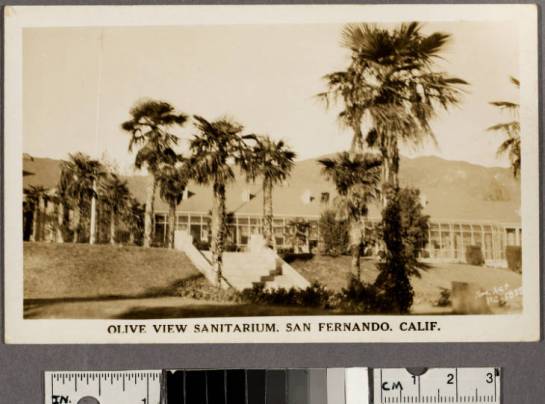Dr. Selma Calmes
Tuberculosis (TB) was the leading cause of death at the turn of the 20th century. The only treatment at the time was thought to be complete bed rest, preferably in a warm, dry climate. Our climate is hot and dry, so Southern California attracted thousands of TB patients in the early 1900s. These patients were overwhelming the County hospital downtown, especially once railroad connections with the East were complete. It wasn’t unusual for TB patients to be taken directly from the railroad station to the county hospital. The state established a Bureau of Tuberculosis in 1915 and paid counties to care for these TB patients. LA County’s Board of Supervisors responded by building Olive View Sanitarium near a large commercial olive grove (thus the name “Olive View”), twenty-five miles from downtown Los Angeles. Olive View Sanitarium opened in November 1920 with nine patients and seven buildings.

Postcard of Olive View, 1920s. From the collections at The Huntington.
Olive View was built on the “cottage plan;” wards were small cottages with sun porches. Patients had to lie still and weren’t allowed to laugh or even sing, so their lungs could “rest.” Because the hospital was geographically isolated, and because few people had cars then, patients at Olive View seldom saw their families. Visiting hours were only on Sunday afternoons. This isolation from their families led Olive View patients to make their own little community. There was a library, a chapel, a barber shop, a post office, a radio station, and a school. A monthly newsletter, The Olive View Point, was written and illustrated by patients and kept patients informed about what was happening. In the 1930s, Olive View produced most of its own food, with fruit orchards, a hog ranch and chicken farm. All these projects were run by patients, many of whom couldn’t work in regular or full-time jobs because of their debilitation from TB. Most of the hospital staff lived on the site. Olive View grew to be the largest TB sanitarium in the western US and was famous for its beautiful campus.

Postcard of Olive View, 1920s. From the collections at The Huntington.

In 1947, the first drugs to cure TB were developed. Olive View was an important test site for these new drugs, which miraculously changed many patients’ lives. The success of these drugs led Olive View to become an acute care hospital in the 1950s. The ghosts of Olive View’s past as a TB sanitarium can still be seen in some of the remaining old buildings and in its archives, now housed at USC Libraries Special Collections.
Dr. Selma Calmes graduated from Baylor College of Medicine in 1965. She began a residency in anesthesiology at the University of Pennsylvania in 1966 and was the only female resident in the program. She served as chair of the department of anesthesiology at Kern Medical Center and at Olive View-UCLA Medical Center. In 1994, she was named vice-chair of the department of anesthesiology at UCLA School of Medicine. Dr. Calmes was instrumental in preserving Olive View’s archives and in arranging for them to be preserved by USC Libraries Special Collections.
